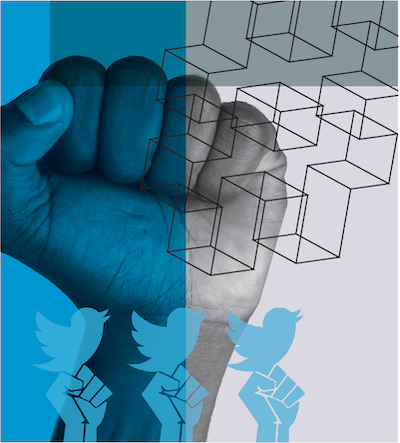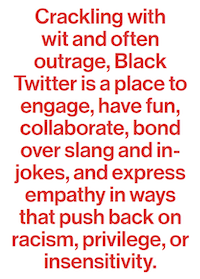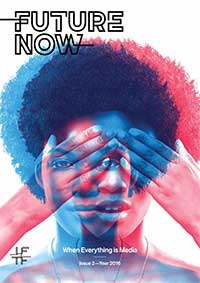Future Now
The IFTF Blog
Black Twitter and the Future of Digital Disobedience
What happens when the Internet of Things “gets woke”?
In an interview not long ago, Twitter co-founder Biz Stone was asked if he had ever heard of “Black Twitter.” Stone admitted he had not, but wondered if it was connected to Black Lives Matter.
Stone is not alone. But even if you’ve never heard of Black Twitter, chances are you’ve heard of one or more of the issues it has pushed into mainstream attention.
From serious political issues like #Blacklivesmatter (fighting unjust police violence against blacks) to #Oscarssowhite (exposing Hollywood’s discriminatory hiring practices) to the funny and trivial #Epicbraidslevel (ridiculing Marie Claire magazine’s suggestion that TV celebrity Kendall Jenner popularized braided hair), Black Twitter has emerged as a voice for African-American concerns, challenging and sometimes upending dominant narratives in politics, media, and culture. Black Twitter’s success also signals something important about the ways cultural and activist driven movements will use ambient communications technologies in the next decade.
 As even Biz Stone now knows, Black Twitter is not a separate entity from Twitter at all but rather an informal platform within the platform—a space hacked out by young African-American tweeters weighing in on everything from celebrity culture to politics. Crackling with wit and often outrage, it is a place for participants to engage, have fun, collaborate, bond over slang and in-jokes, and express empathy in ways that push back on racism, privilege, or insensitivity. For example, in the new popular meme #IDontworkhere, tweeters recount incidents in restaurants or hotels when they are mistaken by white people for waiters or salespersons. Black Twitter hashtags trend so regularly now that in the summer of 2016 the Los Angeles Times newspaper hired its first ever Black Twitter reporter.
As even Biz Stone now knows, Black Twitter is not a separate entity from Twitter at all but rather an informal platform within the platform—a space hacked out by young African-American tweeters weighing in on everything from celebrity culture to politics. Crackling with wit and often outrage, it is a place for participants to engage, have fun, collaborate, bond over slang and in-jokes, and express empathy in ways that push back on racism, privilege, or insensitivity. For example, in the new popular meme #IDontworkhere, tweeters recount incidents in restaurants or hotels when they are mistaken by white people for waiters or salespersons. Black Twitter hashtags trend so regularly now that in the summer of 2016 the Los Angeles Times newspaper hired its first ever Black Twitter reporter.
The CNN of the Ghetto
To understand how activist and cultural movements will work in the future, it’s helpful to know how they developed and how they work now. Forty years ago in New York City, low-income black and Latino teenagers who felt they were without a voice in popular culture took an existing piece of equipment—the record turntable—and repurposed it, turning it into a new kind of instrument. This led to the birth of hip hop music. Hip hop started off as fun and engaging, but quickly became a vessel for much more, carrying messages of empathy, persuasion, politics, and all sorts of activism, including raising awareness about police brutality.
The artist Chuck D of the rap group Public Enemy described this connection best when he referred to hip hop music as “the CNN of the ghetto,” transmitting bulletins about the struggles of daily life on urban America’s mean streets. While hip hop once paralleled CNN, in a future connected by ambient communications, activists will use Black Twitter, and platforms like it, to send bulletins through a wider variety of channels—including phones, wristwatches, eyeglasses, virtual reality, and multisensory devices—to witness what’s happening on the ground. Through the use of this new palette of ambient communications technologies, Black Lives Matter and movements like it will be able to encourage greater collaboration and exercise more control and persuasion over their messages, engaging followers more deeply.
The Underground Railroad of Activism
Another important facet of how activists will work was touched on by a blogger writing under the digital pen name Feminista Jones, who asked, “Is Twitter the underground railroad of activism?” Jones saw a connection between the use of Black Twitter today as a kind of modern guidepost with the underground railroad of the 19th century. In the American South before the Civil War, underground railroad “stations” were safe houses providing shelter to runaway slaves risking their lives to escape to freedom. The “railroads” they followed were actually not railroads at all but footpaths between safe houses.
Whether woven into a woolen quilt or carried digitally, coded symbols and slang allow a community to hide in plain sight, using existing channels and platforms to share challenging or subversive messages, often right under the noses of the powers-that-be. Black Twitter users and activists on other platforms will use a constantly changing vocabulary as reference points to help their followers interpret events, reject false information, and guide them not just through physical space but also through virtual landscapes of ideas.
The increasingly rich flow of information we will see in the next decade will likely help activists and community builders expand their followings by capturing and sharing their most compelling experiences.
Streams of Trust and Empathy
 Whether it’s taking to the streets for civil disobedience, singing along to a protest song at a concert, or simply sharing inspiring narratives, ambient communications will allow these experiences to carry greater immediacy and persuasive power than ever before. Even routines of daily life may take on new significance. Activist Shaun Tai, executive director of Oakland Digital—a digital training center in Oakland, California—shares his daily life through Snapchat. He captures photos, conversations, text, video and audio clips, and uploads it all to Google Drive each day. “These streams of regular information—when shared—can build up trust and empathy, even among people who never meet face to face,” says An Xiao Mina, a technologist and writer at the San Francisco-based Meedan organization. “We are already seeing immense benefits of communities of color being able to challenge a dominant narrative quickly.”
Whether it’s taking to the streets for civil disobedience, singing along to a protest song at a concert, or simply sharing inspiring narratives, ambient communications will allow these experiences to carry greater immediacy and persuasive power than ever before. Even routines of daily life may take on new significance. Activist Shaun Tai, executive director of Oakland Digital—a digital training center in Oakland, California—shares his daily life through Snapchat. He captures photos, conversations, text, video and audio clips, and uploads it all to Google Drive each day. “These streams of regular information—when shared—can build up trust and empathy, even among people who never meet face to face,” says An Xiao Mina, a technologist and writer at the San Francisco-based Meedan organization. “We are already seeing immense benefits of communities of color being able to challenge a dominant narrative quickly.”
Unlike today, these new connections will no longer be built on a YouTube or Facebook style format where personal celebrities engage and motivate audiences. Although there will always be a place for charismatic individuals in activist movements, command of a richer and more ubiquitous range of media experiences will spread influence among wider numbers of activists.
Hacking and Repurposing Existing Digital Spaces
With media extending more deeply than ever into the real world, and Internet connectedness moving beyond the screen, activists will also have opportunities to occupy or digitally mark physical space for each other. As MIT researcher and Internet activist Ethan Zuckerman observed, games like “Pokémon Go” “are already showing some amounts of activism around the edges.” Zuckerman describes the potential for augmented reality games or programmable tools to guide activists to gatherings, or provide educational experiences, such as annotating the locations where Trayvon Martin and Michael Brown died (Martin’s killing by a Florida neighborhood watchman in 2013 and Brown’s death at the hands of Ferguson, Missouri police in 2014 catalyzed the Black Lives Matter movement). Imagine an equivalent of Poké Stops where activists train and learn. Digitally illuminated sites will be used to identify safe spaces for activists and other participants, giving movements greater control and amplification.
Even with these technology-propelled strategies, activists may still face challenges in sustaining political change and control. “Technology and new media can work very well at counterpower,” explains MIT’s Zuckerman. “They can identify something people dislike and help tear it down. It worked in Egypt. But what’s much harder to get traction is coordinating and asserting power.”
Hacking and repurposing existing digital spaces, using coded language to engage followers and hide messages in plain sight, and marking the physical world with digital information define key strategies that cultural and activist movements will use over the next decade. In a world where communications technologies are embedded in an infrastructure of everyday objects, and multisensory communications between people and things become routine, these movements will enjoy wider possibilities for growth and greater control over their messages. Built on an “awakened” world of connected things, these movements will align their messages and actions with the changes they want to see in the world. Perhaps it’s no accident that an emerging popular expression among Black Lives Matter adherents today urges awareness and adaptability—to “stay woke.”
 FUTURE NOW—When Everything is Media
FUTURE NOW—When Everything is Media
In this second volume of Future Now, IFTF's print magazine powered by our Future 50 partnership, we explore the future of communications, tracing historical technology shifts through the present and focusing on the question: “What is beyond social media?”
Think of Future Now as a book of provocations; it reflects the curiosity and diversity of futures thinking across IFTF and our network of collaborators. This issue contains expert interviews, profiles and analyses of what today’s technologies tell us about the next decade, as well as comics and science fiction stories that help us imagine what 2026 (and beyond) might look and feel like.
About IFTF's Future 50
Every successful strategy begins with an insight about the future. Every organization needs to build the capacity to anticipate the future. The Future 50 is a side-by-side relationship with Institute for the Future; it’s a partnership focused on strategic foresight on a ten-year time horizon. With 50 years of futures research in society, technology, health, the economy, and the environment, IFTF has the perspectives, networks, signals, and tools to make sense out of the emerging future.
For More Information
For more information on IFTF's Future 50 Partnership and Tech Futures Lab, contact:
Sean Ness | sness@iftf.org | 650.233.9517



